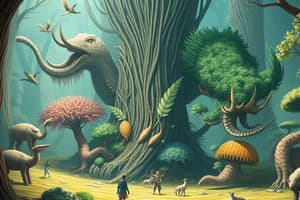Podcast
Questions and Answers
Which kingdom consists of prokaryotic, single-celled organisms that reproduce asexually through binary fission?
Which kingdom consists of prokaryotic, single-celled organisms that reproduce asexually through binary fission?
- Fungi
- Protista
- Monera (correct)
- Plantae
What defines organisms in the Kingdom Protista?
What defines organisms in the Kingdom Protista?
- Multicellularity
- Membrane-bound nucleus (correct)
- Prokaryotic nature
- Heterotrophic nutrition
Which kingdom includes eukaryotic organisms known for their roles in decomposition and mycorrhizal relationships?
Which kingdom includes eukaryotic organisms known for their roles in decomposition and mycorrhizal relationships?
- Plantae
- Protista
- Monera
- Fungi (correct)
Organisms in which kingdom are primarily autotrophic and produce their own food through photosynthesis?
Organisms in which kingdom are primarily autotrophic and produce their own food through photosynthesis?
Which kingdom is characterized by its diverse range of algae, protozoans, and slime molds?
Which kingdom is characterized by its diverse range of algae, protozoans, and slime molds?
The lack of a membrane-bound nucleus is a characteristic of which kingdom?
The lack of a membrane-bound nucleus is a characteristic of which kingdom?
Why is taxonomy important in biology?
Why is taxonomy important in biology?
Which kingdom includes multicellular, heterotrophic organisms?
Which kingdom includes multicellular, heterotrophic organisms?
What is a characteristic feature of organisms in the Kingdom Monera?
What is a characteristic feature of organisms in the Kingdom Monera?
Which group is not included in the hierarchical classification system of organisms?
Which group is not included in the hierarchical classification system of organisms?
In the animal kingdom, which group consists of animals like insects, spiders, and mollusks?
In the animal kingdom, which group consists of animals like insects, spiders, and mollusks?
Which kingdom is characterized by heterotrophic eukaryotic organisms that play a vital role in decomposition and nutrient cycling?
Which kingdom is characterized by heterotrophic eukaryotic organisms that play a vital role in decomposition and nutrient cycling?
Organisms in Kingdom Monera are distinguished by their lack of ___.
Organisms in Kingdom Monera are distinguished by their lack of ___.
Which kingdom includes a diverse range of eukaryotic organisms that do not fit easily into other kingdoms?
Which kingdom includes a diverse range of eukaryotic organisms that do not fit easily into other kingdoms?
Multicellular, photoautotrophic organisms are primarily found in which kingdom?
Multicellular, photoautotrophic organisms are primarily found in which kingdom?
Which kingdom encompasses prokaryotic unicellular organisms like bacteria and archaea?
Which kingdom encompasses prokaryotic unicellular organisms like bacteria and archaea?
The Kingdom Animalia is not discussed in the text, but it is known for its ___.
The Kingdom Animalia is not discussed in the text, but it is known for its ___.
Study Notes
Exploring the Kingdoms of Life: Biology's Classification System
Life, as we know it, is organized into five major kingdoms, each with its distinct characteristics and members. These kingdoms represent a foundational way to classify and understand the incredible diversity of living organisms on our planet.
Kingdom Monera
Monera is the simplest kingdom, consisting of prokaryotic, single-celled organisms. Notable members include bacteria and archaea. Monera are characterized by their lack of a membrane-bound nucleus, instead possessing circular DNA, and they reproduce asexually through binary fission.
Kingdom Protista
Protista is a kingdom of eukaryotic, mainly unicellular organisms. This kingdom is diverse and includes algae, protozoans, and slime molds. These organisms are defined as eukaryotic, meaning they have a membrane-bound nucleus and membrane-bound organelles.
Kingdom Fungi
Fungi consists of eukaryotic, multicellular and predominantly heterotrophic organisms. They reproduce both sexually and asexually and are best known for their roles in decomposition, symbiosis, and mycorrhizal relationships.
Kingdom Plantae
Plantae encompasses the multicellular, primarily autotrophic organisms that produce their own food through photosynthesis. This kingdom includes a wide range of life forms, from simple green algae to complex flowering plants.
Kingdom Animalia
Animalia is the kingdom of multicellular, heterotrophic organisms that lack cell walls and move actively or passively to acquire food. This kingdom includes everything from the tiniest protists to the largest whales.
These kingdoms work together to help biologists classify, study, and understand the interconnectedness of life on Earth. Each kingdom is made up of multiple phyla, classes, orders, families, genera, and species, providing a detailed and organized structure to help us comprehend the world around us.
Studying That Suits You
Use AI to generate personalized quizzes and flashcards to suit your learning preferences.
Description
Explore the five major kingdoms of life in biology, each with unique characteristics and members. Learn about Monera, Protista, Fungi, Plantae, and Animalia, how they are classified, and their roles in the ecosystem.




